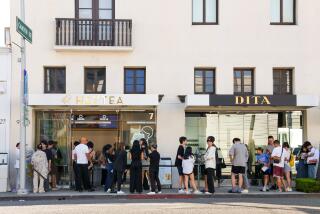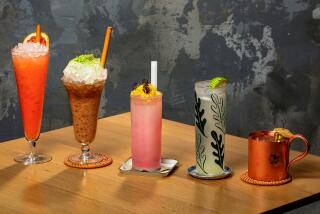Steeped in Tradition : Paul Shelley, butler at the Dana Point Resort, blends guests with high and low afternoon teas.
DANA POINT â âYou must experience the tea,â Paul Shelley reminds his customers, as his white-gloved hands pour his own special brew from a cozy-covered teapot into their floral-patterned Villeroy & Boch china cups. âThe first thing you do is check the bouquet; next, taste it and make a judgment whether we need to add milk or sugar or lemon. But check it out first, because this is a tea you havenât had before.â
You can say that again, and not just of Shelleyâs proprietary blend of teas, which he calls âThe Butlerâs Brew,â but the whole shebang of the afternoon tea service he presides over at the Dana Point Resort every Friday, Saturday and Sunday. The Resortâs Lantern Bay Lounge may be distinctly Southern Californian in its Pacific view and clean-swept lack of personality, but under Shelleyâs guidance it becomes an outpost of upper-crust England, where everything stops for tea.
Tea may be the wan cousin of coffee locally, since gourmet coffee shops have been cropping up like slugs after a Seattle storm, but it is tea that is the most popular beverage in the world; tea that has a history reaching back thousands of years; tea that has been the maker of financial empires, the cause of two intercontinental wars, the root of the opium trade in China and one of the brewing causes of the American Revolution, leading colonists to turn Boston Harbor into the worldâs largest teapot in December 1773. It was tea, I tell you. Tea! Tea!! TEA!!!
Sorry, I donât know what came over me, except that after spending a while with Shelley, you start thinking about tea a tad.
The 50-ish Shelley isnât British, but he might as well be, with his devotion to tea and his adherence to the distinctly British way of putting oneself at the service of others. He doesnât need the badge he wears reading Butler to define his role. Even when having an off-duty chat with him, if you start to take off your jacket, he immediately leaps to his feet and helps. Suggest that he relax and just be a normal human for a while, and he responds, âThis is the way I always am. What you see is what you get. This is how I am in my own house.â
*
Shelley said a tradition of service just comes naturally to those raised in Boston, not that Iâve ever had Ted Kennedy help me with my jacket. He also said tea was a part of life while growing up there, a twice-a-day tradition in his home since he had his first sip at age 5. It set his young mind to musing.
âAs a child I was raised with milk and sugar in tea, and in England many people add the milk before they even pour the tea. I was interested in why ? Why do we put milk in? Why not take it in its original form, namely tea, black? Why do I have to put milk in tea? Do you put it in some, not in others? What does it do to the tea? In my childhood I would ask, why do you put milk in it?â
So, Paul, why do people put milk in tea?
âSome say it enhances the flavor of it, but from the information I have learned, and from my experience and listening to a lot of guests from different countries, you know, the cultures vary. In England, for example, theyâll say, âWhoâll be mum?â But in Australia itâs âWhoâll pour?â
âBut to get back to why milk is placed in tea: Historically, the china was very delicate, and if you put hot, scalding, boiling water into the cup, it might crack. So what they did was, they would put cold milk in it first,â Shelley concluded. Remember, you heard it here first.
*
Between sips, he attended the New England Conservatory of Music and Boston Conservatory of Music. He has taught music at both the college and elementary school level, but cutbacks, which always slash the arts first, left him available three years ago to create the position of butler at the resort, originating and managing the afternoon tea.
He stresses, âHere we serve afternoon tea as opposed to high tea. Historically, high tea was for the commoner. It was more in the early evening, and they would have lots of hot foods, bacon, sausage, crumpets and the like. Afternoon tea was for the aristocrats and the affluent.â
In practice, that means afternoon tea isnât the place to pig out, though one doesnât exactly go hungry either. Shelley offers a choice of the $6.25 spread--a pot of tea, a splendid scone, cream, jam and berries--or the $11.25 one, which has the aforementioned goodies along with finger sandwiches and two dessert pastries, which, like the scone, are skillfully made in-house. There is a choice of several teas, along with Shelleyâs Butlerâs Brew, a balanced full-bodied tea with no aftertaste.
However good he might be at blending tea leaves, Shelleyâs true skill lies in getting people to mix.
âHistorically, tea was a time when ladies and gentlemen would get together and they would share gossip. What we try to do here is set the theme of gossip in a friendly way. My philosophy in the tearoom is whatever you share with us, if itâs dull we spice it up, and then we talk about you.â
Usually what passes for gossip there is stultifyingly innocuous. On this particular afternoon, three sweet elderly ladies visiting from the Midwest shared that they were planning to drive to Hearst Castle and wanted to know how long it would take. One tea drinker told them it might take three hours, while another said six, proving, if nothing else, that sobriety isnât all itâs cracked up to be.
Shelley said most of the âgossipâ was like that, friendly tips on where to shop or what to eat, or light tales from customersâ work day. There have been exceptions, though, such as the time he set a group of female ministers to gabbing. âThe gossip got so heated I had to leave. Iâm amazed at what comes out of the mouths of women,â he said.
*
He started the gossip policy shortly after he began the tea service at the resort. âIâd noticed a pair of guests sitting alone had been at the resort for a week. I reasoned that, like anyone who spends a lot of time together, they must eventually run out of things to say. Every time Iâd come over, theyâd start talking, and when Iâd leave there would be silence. So I started getting the guests to talk to each other.
âWe give the guests the option to either share or keep a low profile. Iâm sensitive to the needs of the guest. If they want solitude, so be it,â he said.
âPaul gets people interested in talking to each other, like a tour director, blending people,â says regular customer Kathy Martino of Dana Point, who was taking tea with her mother. âPaulâs wonderful. He takes an interest in the people who come in.
âIâd gone to tea at the Ritz (Carlton), and it was real stiff. They wouldnât let me in wearing shorts, and everyone was sitting up real prim and proper. Itâs not relaxing. Coming here is just like coming home, but being treated well. It gives a little bit of specialness to your everyday life.â
Shelley said thatâs his goal. âWhen people come in here I want them to experience tea. Traditional tea is a time to relax, to read a book by yourself or to share with others. When I see someone come in whoâs having a bad day, I try to turn them around, to help them leave feeling more positive than when they came in. Tea in parts of Europe was something set aside from the day that no one interfered with. At tea time everything stopped, and people sat down and relaxed. Iâd like to see that happen again here.â
More to Read
Sign up for The Wild
Weâll help you find the best places to hike, bike and run, as well as the perfect silent spots for meditation and yoga.
You may occasionally receive promotional content from the Los Angeles Times.






